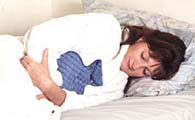Heat halts stomach pain and other aches in the body
Grandmothers can now draw on more than years of experience when they recommend a hot-water bottle to soothe stomach pain and other aches. A new study has found a molecular explanation to support the popular belief.

Applying heat of at least 40 degrees Celsius (104 Fahrenheit) to the skin provides pain relief for up to an hour ``much in the same way pharmaceutical painkillers do,'' Brian King and other researchers at University College London found.
Doctors have recommended heat to relieve back aches, menstrual cramps and colic since the time of Hippocrates, the Greek physician, around 400 B.C. Until now, it was unclear how the rising temperature helped soothe the pain, reports Bloomberg.
Now scientists have figured out how heat applied externally relieves internal pain.
"The pain of colic, cystitis and period pain is caused by a temporary reduction in blood flow to or over-distension of hollow organs such as the bowel or uterus, causing local tissue damage and activating pain receptors," explains Brian King of the University College London. "The heat doesn't just provide comfort and have a placebo effect—it actually deactivates the pain at a molecular level in much the same way as pharmaceutical painkillers work," informs Live Science.
According to Register, a molecule called adenosine tri-phosphate, which can act as a neuro-transmitter and neuromodulator, is released by damaged (i.e. dying) and dead cells. It is used as a fuel by the body, but it also activates the P2X3 pain receptors, causing the sensation of pain.
If heat receptors, called TRPV1, in the same region are activated by the application of heat of over 40°C to the skin, they can block the signals from the P2X3 receptor, thus stopping the body from feeling any pain for up to half an hour.
Dr King says although the pain relief is only temporary, the work demonstrates that the P2X3 receptor is key to the development of new pain-killing drugs.Subscribe to Pravda.Ru Telegram channel, Facebook, RSS!





